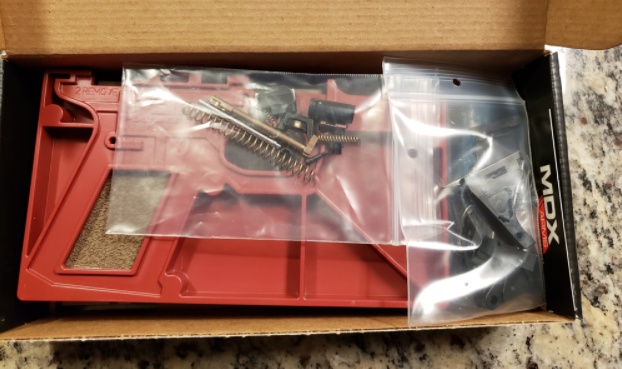What Are Ghost Guns?
“Ghost guns” are untraceable and unregulated firearms that can be bought and built without a background check — even by minors and people who are legally prohibited from buying guns. They’ve become more prevalent across the country and they undermine countless gun safety laws.
Team ENOUGH Executive Council member Stephan Abrams purchased a ghost gun kit at just 17 years old in his home state of California. He had the kit delivered to his house where he could have easily assembled the weapon and had a fully functioning handgun in under an hour.
Ghost guns are unserialized, untraceable, and unregulated firearms that can be bought online and assembled at home. They are often sold through "ghost gun kits,” which include all of the parts and equipment necessary to build these weapons with ease. Ghost gun kits are widely available to the public and can be purchased by anyone — including prohibited purchasers, minors, and gun traffickers — without a background check. As these kits and guns are sold throughout the country, they undermine the life-saving policies that state legislatures have fought so hard to put in place to prevent gun violence.
Some states, like New York, California, and Connecticut, have taken bold action to regulate ghost guns and kits. But until we have more state and federal action, ghost guns will continue to be a growing weapon of choice among people who are legally prohibited from buying guns.
How Ghost Guns Are Assembled
Ghost guns are assembled using unfinished frames or receivers, which is the piece of the firearm that contains the operating parts of the firing mechanism. While federal law regulates frames and receivers, when a frame or receiver is “unfinished” even by a small fraction, it is considered unregulated, allowing ghost guns to be sold and shipped nearly finished to its purchaser.
Ghost gun kits include all of the necessary component parts to turn the unfinished frame or receiver into a fully functioning gun, which once assembled, looks, feels, and functions like a traditional gun. Whether a handgun or assault weapon, ghost guns are just as lethal and dangerous in the wrong hands. Currently in America,
There are no federal restrictions on who can buy ghost gun kits or parts
There are no federal limitations on how many ghost gun kits or parts someone can buy
Ghost gun kits and parts are intentionally marketed as unregulated and untraceable to appeal to gun traffickers and those who want to avoid background checks
Ghost gun kits and parts are cheap and easy to purchase
What does a ghost gun kit look like?
This is a ghost gun kit that was purchased for $400 cash at a California gun show — no background check, no bill of sale.
The Impact of Ghost Guns
At the height of the COVID-19 pandemic, reports found that ghost guns “were flying off the shelves.” But even before the coronavirus, the sale of ghost gun parts and kits increased significantly in recent years. In 2020, Carlos A. Canino, the Special Agent in charge of the ATF Los Angeles Field Division, explained: “Forty-one percent, so almost half our cases we're coming across are these ghost guns."
In return, tragically, the use of ghost guns in crime has increased exponentially. In 2017, three ghost guns were recovered by law enforcement in the District of Columbia. In 2018, it was 25 ghost guns. In 2019, 116 ghost guns were recovered, and at least three in connection with homicides. Just two months into 2020, 38 ghost guns had already been recovered, which suggests over 220 ghost guns will be recovered in crime in 2020.
Ghost guns have also been used in three separate mass shootings in California, including Saugus (2019), Tehama County (2017), and Santa Monica (2013). Twelve people, including two teenagers, were killed in these shootings and dozens more were shot and injured. The Tehama and Santa Monica shooters were prohibited from purchasing firearms, and the Saugus shooter was a minor who, by virtue of his age, was not legally able to possess any firearm under California law.
The Bureau of Alcohol, Tobacco and Firearms (ATF) and How to Regulate Ghost Guns
The Bureau of Alcohol, Tobacco and Firearms (ATF) is the government agency responsible for enforcing our nation’s firearms laws. They are also the only federal agency with jurisdiction to conduct regulatory oversight of the gun industry. However, the ATF has been historically understaffed, underfunded, and they’ve been without a Senate-confirmed director since 2015. While numerous gun lobby-backed laws have passed in Congress, they’ve crippled the ATF’s ability to adequately enforce existing laws and properly regulate the gun industry.
Meanwhile, more than 100 Americans are shot and killed each day in America.
Living up to his campaign promises, in 2021, President Biden took administrative action to address these issues at the ATF and more. He nominated gun safety advocate David Chipman as the permanent director to head the ATF, and called on the Justice Department, within 30 days, to issue a rule to help stop the proliferation of ghost guns.
We at Team ENOUGH urge Congress to confirm Chipman to head the ATF so we can begin to regulate the firearm industry, crackdown on illegal gun trafficking, and further address ghost guns in America.
The steps that @POTUS is taking to regulate ghost guns and hold the gun industry accountable are extremely important in the fight to create a safer future for my generation.
— Stephan Abrams (@StephanAbrams) April 8, 2021
This was all made possible because we never stopped fighting. @Team_Enough https://t.co/UG8i8kyiL6
And while federal action on ghost guns is on the horizon, we’re also calling on states across the country to act now to proactively prevent ghost guns from becoming more prevalent. New York, New Jersey, Connecticut, California, Washington State, and the District of Columbia have all taken action to regulate or ban ghost guns, and several other states are considering similar legislation.

